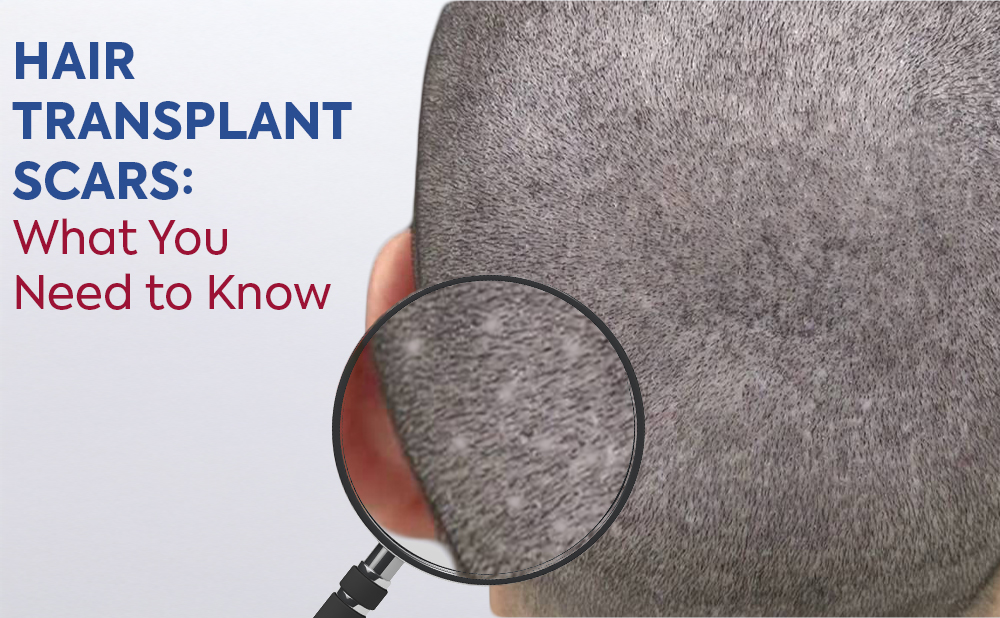
Hair transplant scars are small and often go unnoticed, but they do exist. No matter how advanced the method is, some level of scarring will occur; usually in the donor area where the follicles are taken. With techniques like FUE, DHI, and Sapphire FUE, these marks are dot-sized and tend to fade well over time.
This article looks at what kind of scarring to expect, what affects how it heals, and what can be done if a scar becomes visible. If you’re considering a transplant or already recovering, knowing these details can help you better understand the process and what a realistic outcome looks like.
Do Hair Transplants Leave Scars?
Yes, even with the most advanced techniques like FUE, DHI, or Sapphire FUE, hair transplants involve tiny incisions that result in small scars. This is a normal part of the healing process, as your skin naturally responds to these micro-wounds by forming scar tissue.
However, unlike older methods, these modern approaches are designed to make scarring as minimal as possible. The scars are typically dot-sized and spread across the donor area, making them nearly invisible unless the hair is shaved extremely short. In most patients, they fade significantly over time and become almost undetectable.
When performed by a skilled surgical team using the latest tools and proper technique, these minor scars heal cleanly and do not affect the overall appearance or result of the transplant.

Types of Hair Transplant Scars
The kind of scarring that occurs after a hair transplant depends on the surgical method used. Modern techniques such as FUE, DHI, and Sapphire FUE are designed to minimize visible scarring, but they still involve tiny incisions that leave some degree of mark on the scalp.
FUE Scars
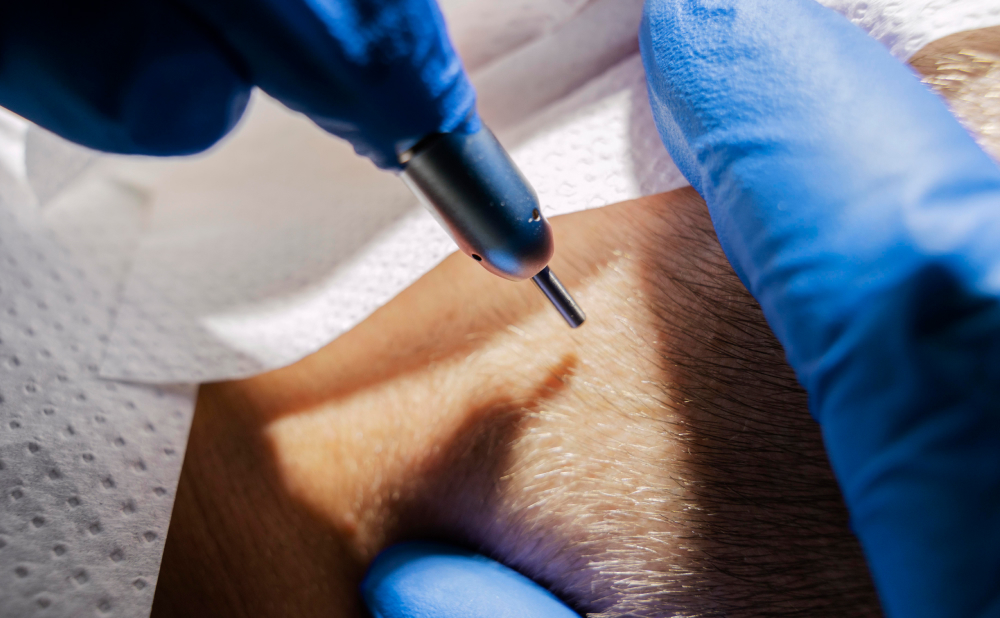
Follicular Unit Extraction (FUE) removes individual hair follicles using a small circular punch tool. This process results in scattered, dot-like scars in the donor area. These are typically small and heal well, often blending in with surrounding hair and difficult to notice unless the hair is shaved very short.
DHI Scars

Direct Hair Implantation (DHI) follows a similar extraction process as FUE but uses a specialized implanter tool for placement. The resulting scars are also dot-sized and spread across the donor area, usually healing with minimal visibility.
Sapphire FUE Scars
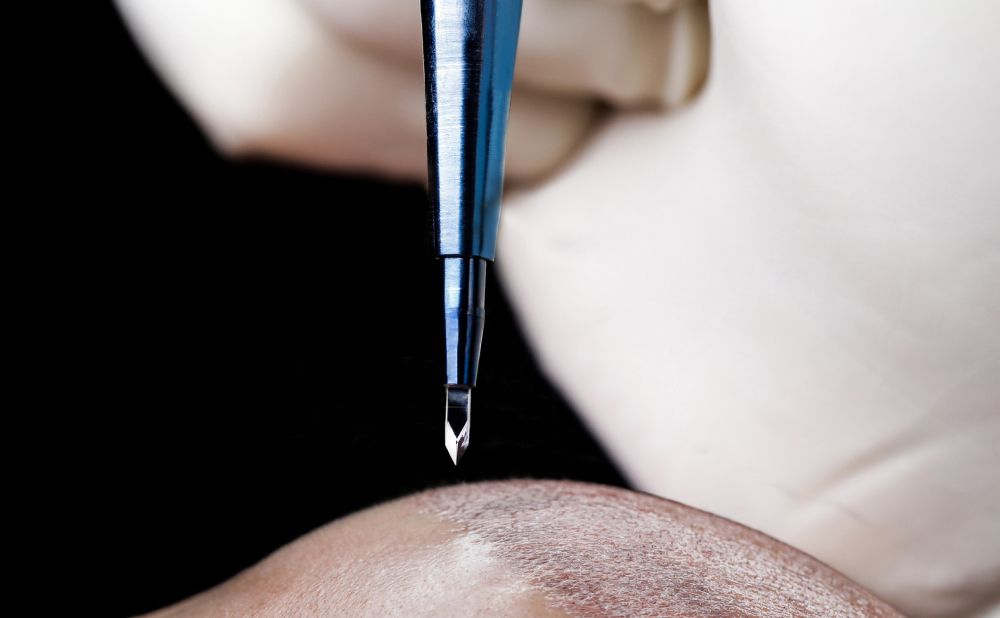
Sapphire FUE method uses a blade made of sapphire to create finer incisions during the implantation process. The precision of the sapphire blade can lead to smaller, cleaner wounds, which may result in less noticeable scarring over time.
Hair Transplant Scars Comparison Table
| Technique | Scar Type | Visibility |
|---|---|---|
| FUE | Micro-dot scars | Generally hidden unless hair is shaved |
| DHI | Micro-dot scars | Subtle and widely spaced |
| Sapphire FUE | Smaller dot scars | Often fade quickly and are hard to detect |
These techniques are all designed with scar minimization in mind, but healing can vary depending on individual factors such as skin type, hair density, and post-op care.
What Affects Hair Transplant Scarring?
Even with minimally invasive techniques, several factors influence how noticeable a hair transplant scar might be. While the surgical method plays a key role, the healing process is also affected by individual characteristics and how well post-operative care is managed.
Key Factors That Influence Hair Transplant Scars:
- Skin Type and Healing Response: Some people naturally form thicker or more visible scar tissue due to genetics. Conditions like keloid or hypertrophic scarring are rare but can affect healing.
- Tool Size and Precision: The diameter of the punch tool used during extraction can impact scar size. Smaller, more precise tools typically lead to finer scarring.
- Surgeon’s Technique: Even advanced techniques require experience and attention to detail. Consistent spacing and angle control reduce trauma to the scalp and improve the cosmetic outcome.
- Post-Operative Aftercare: Following washing instructions, avoiding sun exposure, and keeping the donor area clean are all essential for proper healing and scar reduction.
- Lifestyle Factors During Healing: Smoking, poor nutrition, or scratching the scalp can delay healing and increase the risk of visible scarring.
How Noticeable Are Hair Transplant Scars?
In most cases, hair transplant scars are barely visible, especially when the hair is worn at a typical short or medium length. Modern techniques like FUE, DHI, and Sapphire FUE are designed to minimize scarring, and for many patients, the tiny marks in the donor area are only noticeable if the scalp is closely shaved.
Factors That Affect Scar Visibility after Hair Transplant:
- Hair Length: The shorter the haircut, the more likely it is that small dot-like scars will be visible. With longer hair, they’re typically well hidden.
- Hair and Skin Contrast: Scars may be more noticeable if there’s a strong contrast between hair color and skin tone, especially in lighter skin types with dark hair.
- Donor Area Density: If the donor area has high follicle density, small scars are easily masked. In areas with thinner density, spacing may be more noticeable.
- Healing Quality: Scars fade over time, especially when proper aftercare is followed. Some may become barely visible within a few months.
Can Hair Transplant Scars Be Prevented or Minimized?
Hair transplant scars can’t be completely avoided, but there are several ways to reduce their visibility and support optimal healing. Both the surgical approach and your own aftercare efforts play a major role.
Tips to Minimize Scarring after Hair Transplant:
- Choose a Technique That Matches Your Hair Goals: Methods like FUE, DHI, and Sapphire FUE are specifically designed to keep scarring minimal. Smaller tools and refined implantation methods mean smaller wounds and cleaner healing.
- Follow All Aftercare Instructions Carefully: Keeping the scalp clean, avoiding harsh contact with the donor area, and using prescribed sprays or shampoos as directed helps prevent irritation or infection that can worsen scarring.
- Avoid Scratching or Picking at the Donor Area: Even mild irritation or unconscious touching can delay healing. Resist the urge to scratch, even if the area becomes itchy in the early days of recovery.
- Protect the Scalp from Sun Exposure: UV rays can darken healing skin and make scars more visible. Wear a loose-fitting hat (when safe to do so) or stay in shaded areas during the initial healing period.
- Stay Hydrated and Support Healing from Within: A healthy diet, hydration, and avoiding smoking can all contribute to faster healing and improved skin recovery.
How to Treat or Conceal Hair Transplant Scars
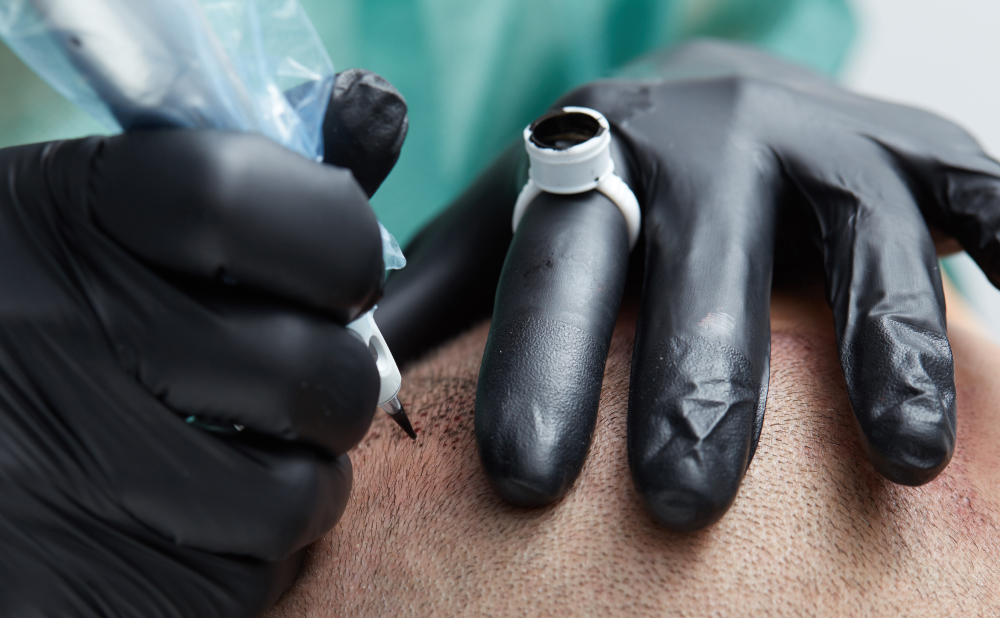
In most cases, hair transplant scars fade naturally over time and are not a concern. However, if scars remain visible or become a cosmetic issue, especially when wearing shorter hairstyles, there are effective ways to treat or camouflage them.
Treatment Options for Hair Transplant Scars:
- Scalp Micropigmentation (SMP): A non-surgical method that involves applying pigment to the scalp to match the surrounding hair, creating the illusion of density and reducing the contrast between the scar and skin.
- FUE into the Scarred Area: In cases where the scar tissue is healthy and has enough blood supply, additional grafts can be implanted into the scar itself to improve coverage.
- Laser Therapy or PRP (Platelet-Rich Plasma): These treatments can improve the skin’s texture, promote collagen production, and enhance overall healing, making the scar less noticeable.
- Topical Treatments: Certain silicone gels or scar creams may help soften the scar tissue or reduce pigmentation over time. These are usually most effective during the early stages of healing.
If you’re concerned that your scars are the result of poor technique or aftercare, Hair Transplant Gone Wrong: Signs of Bad Hair Transplant may help you identify what went wrong and what to do next.
What to Expect from Hair Transplant Scars in the Donor Area
After a hair transplant, the donor area is where minor scarring typically appears. This area, usually at the back or sides of the scalp, shows the most immediate signs of healing following the extraction of hair follicles.
Most patients experience mild symptoms that resolve within days to weeks. The appearance of scars depends on your healing process, the technique used, and how closely you follow aftercare instructions.
What You May Notice:
- Redness and swelling: Normal in the first few days
- Small scabs or crusts: Fall off naturally within 7–10 days
- Itching: Common but should be avoided to prevent irritation
- Tiny dot scars: Typically fade and become less visible over time
Small scabs or crusts typically form in the donor area and fall off naturally within a week. If you’re in the early recovery phase, you may also want to read Hair Transplant Scabs: Timeline to Expect Week by Week to better understand how this stage progresses.
Healing and Scar Timeline:
| Time Frame | What Scarring to Expect |
|---|---|
| Day 1–3 | Redness, mild swelling, and small scabs begin forming |
| Day 4–7 | Scabs start to flake off naturally, itching may begin as skin heals |
| Week 2 | Most scabs gone, redness reduced, tiny dot scars visible but not pronounced |
| Week 3–4 | Donor area looks cleaner, scars begin to blend with natural skin tone |
| 1–3 Months | Small scars fade further and are rarely noticeable with short to medium hair |
| After 3 Months | Donor area appears fully healed in most patients, scars are typically minimal |
For a real-life perspective, watch the video below showcasing Morten Bo’s hair transplantation recovery, where you can see how the healing process and scar timeline unfold step by step:
For a broader look at what happens week by week after the procedure, check out Hair Transplant Timeline: A Guide to Hair Transplant Recovery & Growth Chart.
Hair Transplant Without Visible Scars: Is It Possible?
The idea of a completely scar-free hair transplant is one of the most common expectations among patients—but the reality is that every hair transplant involves some degree of scarring, even with the most advanced techniques.
However, the difference lies in the size, placement, and visibility of those scars. With methods like FUE, DHI, and Sapphire FUE, the scars are so small and well-distributed that they often go unnoticed, especially once the hair in the donor area grows back.
What Makes Scars Less Noticeable:
- Smaller extraction tools result in finer, dot-like scars
- Even spacing across the donor area prevents concentrated scarring
- Natural hair coverage hides scars unless hair is shaved very short
- Proper healing and aftercare support skin recovery and fading
Minimize Hair Transplant Scars with Expert Care in Turkey at MCAN Health
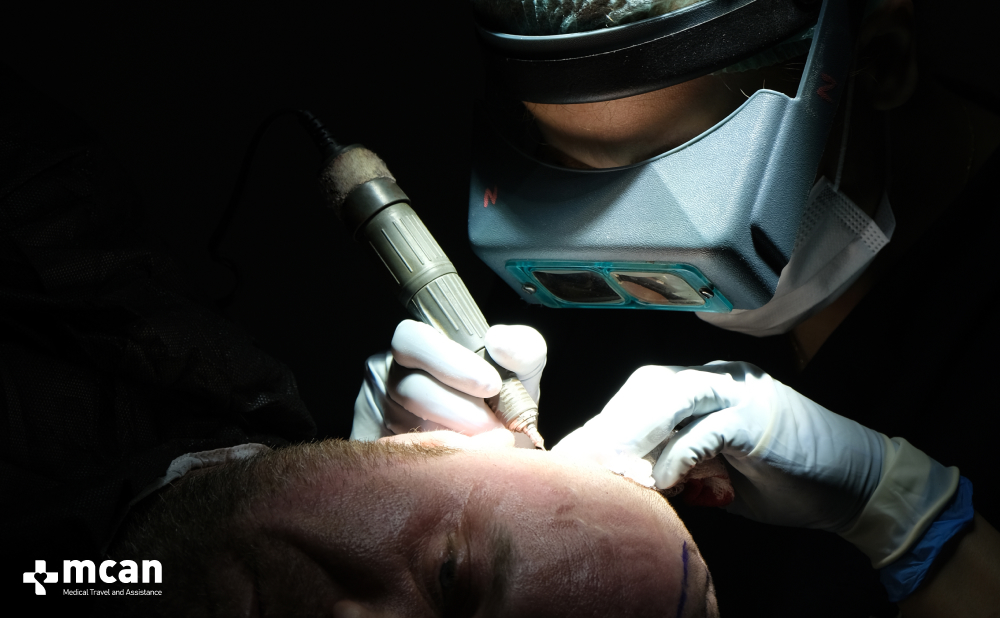
Scarring after a hair transplant is a natural part of the healing process, but with the right method, tools, and post-operative care, it can be reduced to the point of being nearly invisible. The key is choosing a technique that prioritizes precision and working with a team that understands how to protect both your results and your scalp health during recovery.
At MCAN Health, every detail is handled with that goal in mind. From the use of micro-punch tools and sapphire blades to guided aftercare, our team works to keep scarring to a minimum while maximizing your comfort and outcomes. With over 15,000 international patients, a 4.8-star rating, and internationally accredited surgical standards, we help ensure your donor area heals cleanly and confidently.
Looking for a hair transplant in Turkey with natural results and minimal scarring? Book your free consultation and let MCAN Health help you take the next step with expert care you can trust.
Frequently Asked Questions About Hair Transplant Scars
Are hair transplant scars always visible?
No. With modern techniques like FUE, DHI, and Sapphire FUE, scars are usually very small and spread out, making them difficult to notice unless the hair is shaved very short.
Where exactly do hair transplant scars appear?
Scars form in the donor area, typically the back or sides of the scalp, where follicles are extracted. These are dot-sized and fade over time.
Can hair grow through scar tissue?
Hair generally does not grow through scar tissue, but in some cases, healthy follicles can be implanted into the scarred area to improve coverage.
What does a well-healed donor area look like?
After full healing, the donor area usually shows no signs of redness or scabbing. Small white dots may remain, but they are often hidden by hair.
Does scalp tightness or pain indicate scarring issues?
Mild tightness is normal during healing. Persistent discomfort may signal delayed healing but isn’t always linked to scarring. It should be discussed with your provider.
Is it possible to completely remove a hair transplant scar?
Scars can be improved but not entirely removed. Treatments like SMP or grafting into scar tissue can make them far less noticeable.
How can I avoid dark or raised scars after surgery?
Avoid sun exposure, don’t scratch or pick at the area, and follow your clinic’s aftercare routine. These steps reduce the risk of pigmentation changes or raised tissue.
Can hair transplant scars stretch or widen over time?
In rare cases, repeated procedures or poor skin elasticity may lead to more noticeable marks, but this is uncommon with well-spaced extractions.
What’s the best haircut to hide donor area scars?
Most short hairstyles, such as fades or cropped cuts, easily conceal scars unless the hair is shaved extremely close to the skin. Medium-length styles provide full coverage.
 Hello MCAN London! MCAN Health London Cannot Wait to Welcome You!
Hello MCAN London! MCAN Health London Cannot Wait to Welcome You!  MCAN Health Receives Prestigious Award: ‘’Health Tourism Institution of the Year!’’
MCAN Health Receives Prestigious Award: ‘’Health Tourism Institution of the Year!’’  5 Points to Have the Best Hairline for Hair Transplant
5 Points to Have the Best Hairline for Hair Transplant